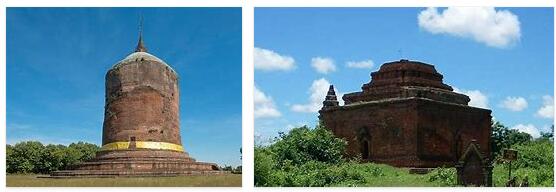Historic cities of the Pyu (World Heritage)
Pyu, name for one of the first advanced civilizations in Southeast Asia.
UNESCO recognized their role by appointing the first World Heritage Site in Myanmar (Burma) in 2014.
These are the remains of the three fortified and moated cities of Halin, Beikthano and Sri Ksetra, which lie in the vast irrigated landscapes of the Irrawaddy (Ayeyarwady) river basin. With over 2000 kilometers in length, the Irrawaddy is Myanmar’s most important and longest river.
The Irrawaddy Basin in the middle section of the river forms the historical core of the country. The Pyu settled here, traces of which went back to the 1st millennium BC. Go back BC. The kingdoms of the Pyu had their heyday of over 1000 years between 200 BC. BC and AD 900 The remains of the only partially excavated cities include palace castles, tombs and handicraft production facilities as well as monumental Buddhist stupas made of brick. In addition, some of the walls of the old buildings are still standing.
Some of the water management facilities are still in use today. They point to the traditional, intensive and well-organized agriculture in this region.
Historic Cities of the Pyu: Facts
| Official title: | Historic cities of the Pyu |
| Cultural monument: | Remains of three fortified cities with palace castles, tombs and handicraft production facilities as well as monumental Buddhist stupas |
| Continent: | Asia |
| Country: | Burma |
| Location: | Irrawaddy river basin in central Burma |
| Appointment: | 2014 |
| Meaning: | The historical cities testify to the heyday of the Pyu kingdoms between 200 BC. BC and AD 900 |
Mandalay
Mandalay [mændə le ɪ ], city in Myanmar, 76 meters above sea level on the middle reaches of the Irrawaddy, (2014) 1.2 million residents (approx. 40% Chinese).
Administrative seat of the province of Mandalay; spiritual center of Burmese Buddhism with many temples, pagodas, monasteries; catholic archbishop’s seat; several universities, technical colleges, institute for art, music and drama; Art gallery, museum; Handicrafts (including marble work, sequin embroidery, gold leaf production). Mandalay is the largest city in the arid central lowlands; agricultural equipment manufacturing, metal and textile industry (especially silk weaving), copper ore smelting, tea processing and packaging, brewery; nearby iron and steel works; Commercial center, tourism; Railway junction (railway and road bridge over the Irrawaddy), international airport since 2001 (near Ava).
Cityscape: The historic city, which extends south of Mandalay Hill, was built in the late 1850s as a systematic complex with a right-angled road network. The royal palace in the northeast of the city (1857–63) was destroyed in 1945 and after 1989 it was rebuilt true to the original. In the Shwe Nandaw Monastery, a foundation from the end of the 19th century, there are parts of the old palace (the former residence of King Mindon, * 1808, † 1878) with originally polychrome, gilded wood carvings.
Among the numerous Buddhist buildings are to be emphasized: Kutho Daw Pagoda (1862), which houses the “Biggest Book of the World” (729 marble slabs in a shrine, each containing the continuous text of the Buddhist “Pali Canon” [Tipitaka]); Maha Muni Pagoda (originally built in 1784, rebuilt in 1884 after a fire) with a particularly sacred Buddha statue; Kyauk Taw Gyi Pagoda (1853) with a 4 m high seated figure of the Buddha made from a block of marble.
History: Mandalay, the successor to Amarapura, the last capital of the Kingdom of Burma, was founded in 1857 by King Mindon (King 1853–78) and taken by British troops in November 1885, causing great destruction. Under British rule, Mandalay was the administrative center of Upper Burma. Occupied by Japanese troops in 1942, the city was reclaimed by the British in March 1945 and again heavily destroyed.
Taunggyi
Taunggyi, capital and cultural center of the Shan state, in the east of Myanmar, 1,430 m above sea level, (2014) 264,800 residents.
Catholic Archbishop’s Seat; University (founded as a technical college in 1961, university since 1992), universities of medicine and technology; Handicrafts, processing of agricultural raw materials and wood; Tourism.
Pegu
Pegu, Bago, city in Myanmar, on Pegu, (2014) 254 400 residents.
Administrative seat of the Pegu region; Wood industry, metal processing, food and textile industry, pottery; Transportation hub and Hanthawady International Airport.
Buddhist pilgrimage destination with numerous historical sacred buildings (Shwemawdaw Pagoda); Statue of the reclining Buddha (Shwethalyaung); King Bayintnaung ‘s palace (16th century; reconstructed in the mid-1990s).
Pegu is the identification of the region Mon. According to tradition, it was first founded after the end of the 8th century, and was called Hamsavati (Mon Hongsawadi, Burmese Hanthawady) from the middle of the 14th century, following the national symbol of the Mon (Hamsa – mythological shelduck); 1349–1539 and 1742–53 was the capital of the Mon empires and 1539–1635 of the Burmese Empire.
